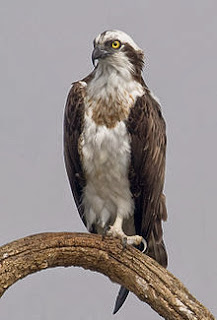Chewk- Chewk- Chewk is the
alarm call of the Osprey.
The Osprey or sea hawk is
one of the most common birds of prey and is found on every continent except
Antarctica. Locally in the U.S.
the Osprey is found everywhere on or near water, and they are not shy about
living amongst humans. The diet of
the Osprey is almost completely comprised of fish and they are completely
specialized for a life style on the water.
An adult Osprey
Common on almost every
continent, the Osprey is a master of its craft as a fisher. With a worldwide population over half a
million, the Osprey is one of the most widespread birds of prey. The Osprey is found in most temperate
regions throughout the world, from Canada to Argentina and Ireland to North
Africa. Temperate zone Ospreys do migrate, typically with the changing of
the seasons in most regions.
The Osprey is specially
designed to hunt on water in many very interesting ways. Sporting long slender
wings and a short tail, the Osprey’s wingspan measures up to 6 feet in large
females. The Osprey is specially
equipped with an outer toe that can rotate toward the
back toe to help catch and hold on to slippery
fish. The
scales on the feet and legs are fashioned in an upward position and is opposite
of all the other birds of prey. These upside down scales make the legs more
hydrodynamic when the bird plunges completely into the water to catch a fish
(Bald Eagles catch fish near the water’s surface). The pads on the bottom of the
Osprey’s feet are made up of tiny barb like bumps. Even the nose holes (nares) of the Osprey can be
closed, which comes in handy when the Osprey hits its prey below the surface of
the water and then has to fly out of the water with the fish.
The Osprey is among just a
few of the legendary and mythical creatures that have been recorded in human
culture from the beginning. This
is probably due to the common connection to water and fishing that humans and
Ospreys share. They are able to
coexist in and amongst humans quite successfully as long as they are
respected.
The Osprey is truly one of
the world’s most successful and magnificent animals. If you would like to see an Osprey up close, stake a stroll
down the WBS display line and visit our resident Osprey, Bennett (from late
March through mid November).
Submitted by Adam Triska,
World Bird Sanctuary Naturalist/Trainer


No comments:
Post a Comment